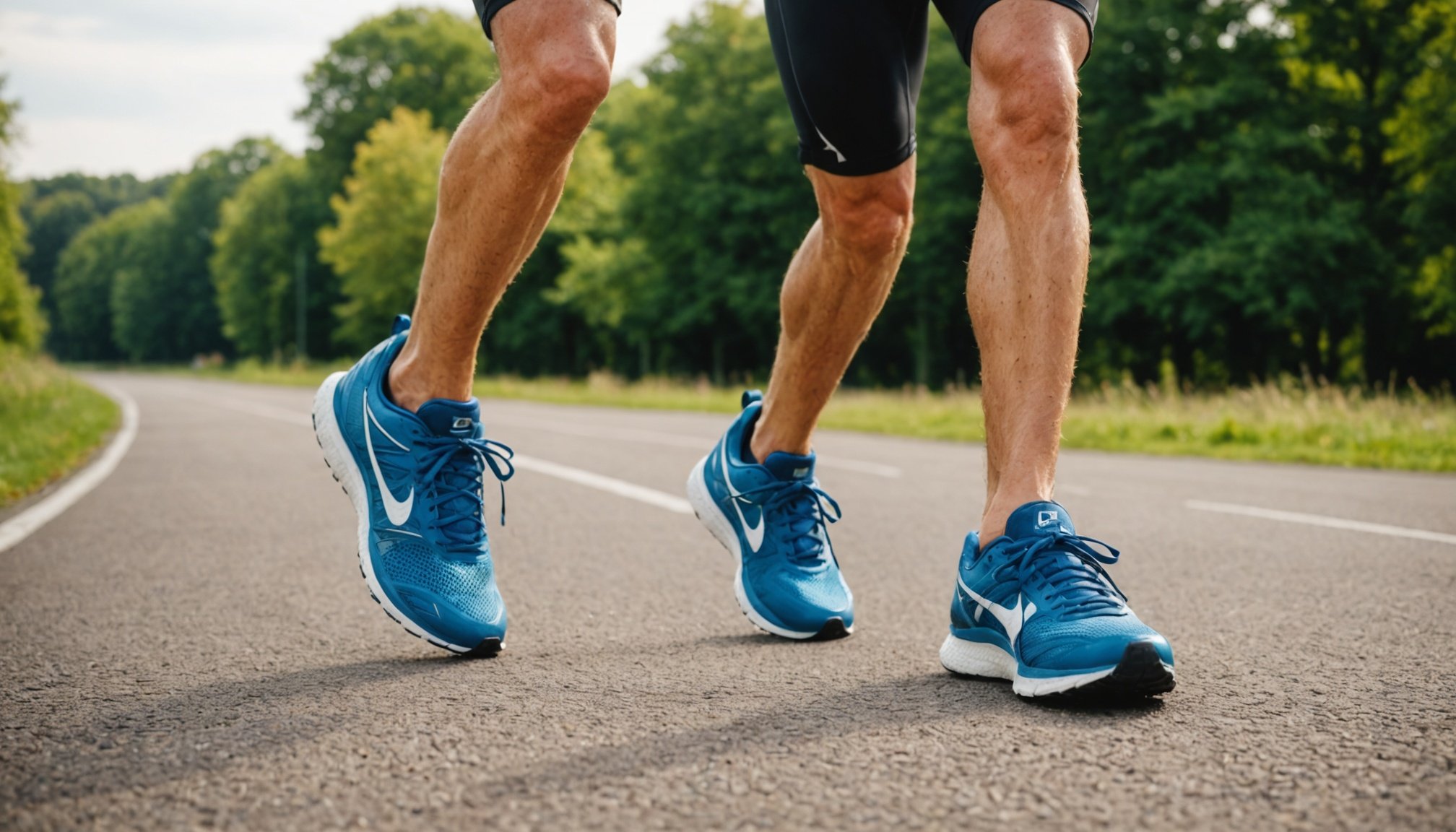Understanding the Importance of Shoe Replacement
When it comes to running performance, footwear plays a crucial role. A well-designed running shoe not only supports your feet but also enhances overall performance by providing optimal cushioning and stability. However, as shoes wear down, their effectiveness diminishes significantly.
Worn-out running shoes increase the risk of injury. The cushioning degrades, leading to less shock absorption and increased stress on the joints. This can result in common injuries like shin splints or plantar fasciitis. Therefore, paying attention to your shoe’s condition is essential for injury prevention.
In the same genre : Thriving Through the Chill: Essential Tips for Boosting Your Mental Well-Being This UK Winter
Timely running shoe replacement ensures that you continue to benefit from the shoe’s design. New shoes can offer enhanced support and improved traction, crucial for maintaining running efficiency. By replacing your shoes at the right time, you’re not only protecting your feet and legs, but also maximising your performance enhancement potential.
Keeping track of your shoe’s mileage (generally between 300-500 miles) can help determine when it’s time for replacement. Listening to your body and noting any new signs of discomfort can also signal that it’s time for new shoes. Thus, regular running shoe replacement is a proactive approach to sustaining healthy and effective running habits.
Also to discover : Top Strategies for UK Parents to Tackle Picky Eating in Children
Signs It’s Time to Replace Your Running Shoes
Recognising the signs that it’s time to replace running shoes is crucial for maintaining optimal performance and preventing injury. A visual inspection can reveal many wear signs indicative of shoe longevity reaching its limit. Examine the outer sole for excessive wear patterns, especially if the tread is significantly worn or smooth. Inspect the midsole for creases or compressed material, which can signal a loss of cushioning and support.
Identifying Physical Signs of Wear
Physical indicators like fraying at the seams or tears in the fabric could mean your shoes are past their prime. Pay attention to the heel section; if it appears uneven or excessively worn, it’s a clear warning sign.
Performance Decrease Indicators
If you notice discomfort, joint pain, or decreased performance during runs, it’s possible your shoes no longer provide the necessary support. This can lead to improper stride and increased risk of injury.
How Weather and Terrain Affect Shoe Lifespan
Frequent running on abrasive terrain or exposure to extreme weather conditions can accelerate wear and tear. Monitor shoes used in harsh environments more closely, as they may need replacement sooner than expected.
Recommended Replacement Intervals for UK Runners
Understanding when to replace running shoes is crucial for maintaining performance and avoiding injury. Replacement intervals depend heavily on running frequency and individual habits. On average, running shoes last between 300 to 500 miles; however, this can vary based on terrain. Shoes used primarily on trails may wear out faster than those used on pavement due to rougher surfaces.
Personal running habits also play a significant role in determining optimal replacement intervals. Runners logging higher weekly miles might find that their shoes require replacement sooner compared to those running less frequently. Monitoring and considering these variables can enhance your running experience.
Effective mileage tracking is key to deciding when to replace your shoes. Methods such as run-tracking apps, which measure the total distance covered, can provide precise mileage data. Additionally, a simple log or spreadsheet can serve as a practical method to keep an eye on your shoe usage. Being diligent about replacement intervals ensures that you maintain comfort and safety during your runs.
UK-Specific Shoe Brands and Models
When exploring running shoe brands, particularly those prominent in the UK, several names consistently rise to acclaim due to their local availability and performance suitability.
Top UK Running Shoe Brands
In the UK, running enthusiasts often gravitate towards brands like New Balance and Brooks. Praised for their durability and support, these UK-specific models cater well to varying local terrains. Their innovative designs enhance performance, ensuring that every stride is both comfortable and efficient.
Ideal Models for Different Running Styles
Choosing the right model hinges on where you’ll hit the pavement. Road running aficionados may prefer models designed for urban landscapes, offering stable cushioning. Conversely, models tailored for trail running provide robust traction indispensable for off-road adventures. It’s crucial to identify your running style to find the perfect match.
Assessing Value and Warranty Options
Evaluating running shoes involves considering both price and durability. Notably, many UK brands offer comprehensive warranties. Balancing cost against long-term performance is essential. A slightly higher initial investment might mean greater longevity and satisfaction. When perusing these options, always weigh how warranties might enhance value, potentially leading to savings if issues arise.
Climate Considerations for Shoe Longevity
In the UK, weather conditions play a significant role in the longevity of your shoes. The country’s climate impact includes high humidity, rain, and temperature fluctuations. These factors can deteriorate materials like leather, suede, and synthetic fabrics, leading to shoes wearing out faster.
Seasonal changes are crucial when selecting running shoes. In winter, water-resistant materials are valuable to protect from wet conditions, while breathable materials are best in summer for heat management. Seasonal considerations can enhance the shoe’s lifespan by matching them to appropriate materials.
To maintain shoes under varying weather conditions, remember these key tips:
- Waterproof your shoes using sprays or conditioners suitable for the shoe material to prevent moisture damage.
- Rotate multiple pairs to allow each to dry thoroughly, reducing the risk of weakening shoe integrity.
- Clean off any dirt or mud promptly, as leaving these can degrade material over time and compromise shoe care.
These strategies not only protect your investment but also ensure your footwear remains functional and comfortable throughout the year. Understanding how local climate influences footwear enhances decision-making in selecting and maintaining shoes effectively.
Injury Prevention Strategies for Runners
Injury prevention is a critical component of any runner’s training routine. Integrating cross-training techniques can help achieve a well-rounded regimen and reduce the risk of injuries.
Integrating Cross-Training into Your Routine
Cross-training offers a variety of benefits for runners aiming to reduce overuse injuries. By incorporating diverse workouts like swimming, cycling, or strength training, runners can strengthen different muscle groups, enhance endurance, and improve overall fitness. It’s essential to schedule regular cross-training days to allow the body to adapt and minimise repetitive strain on the same muscle groups used during running.
Importance of Rest and Recovery
Equally important is rest and recovery. It is during rest periods that muscles repair and strengthen, which is crucial for avoiding injuries. Effective rest days should involve activities like light stretching or yoga, rather than complete inactivity, to maintain flexibility. Following structured rest guidelines based on your training intensity ensures you reap the full benefits of your hard work.
Listening to Your Body’s Signals
Understanding and heeding your body’s signals is paramount. Early signs of discomfort or fatigue should not be ignored, as addressing these signals early can prevent more severe issues. Be proactive: if in doubt, consult professionals to avoid exacerbating potential injuries. Recognising these signs and being proactive is vital for any injury prevention strategy.
Expert Recommendations and Testimonials
Receiving expert advice can be pivotal for runners seeking optimal shoe performance. Insights from both professional coaches and podiatrists highlight how different shoes contribute to running success. Coaches often emphasise the importance of a shoe’s fit and support, urging athletes to select models that complement their foot structure and running style. Podiatrists, meanwhile, focus on ergonomics, advising shoes that prevent common injuries like plantar fasciitis.
Personal Experiences from UK Runners
Many UK runners share their experiences with specific shoe models. They often detail how these shoes enhance their running experience and help in achieving personal goals. Runners note factors such as cushioning, durability, and adaptability to different terrains. These personal testimonials offer invaluable insights into how different shoes perform in real-world conditions.
Community Insights
Community forums serve as platforms for sharing knowledge and tips among runners. Here, individuals can exchange advice on shoe care, training techniques, and product recommendations. These forums foster a communal sense of encouragement, allowing both novice and seasoned runners to benefit from collective wisdom. By engaging with these communities, runners ensure they make informed, practical decisions regarding their footwear.











